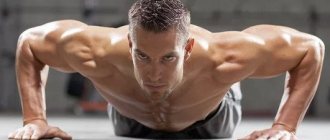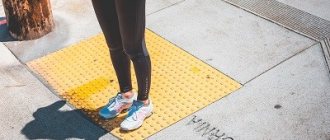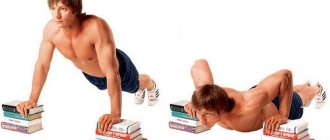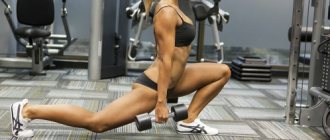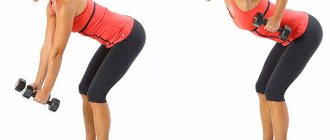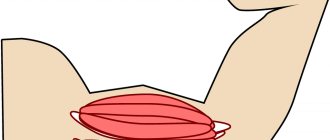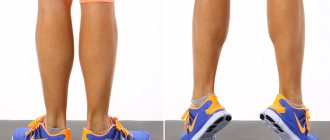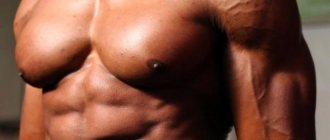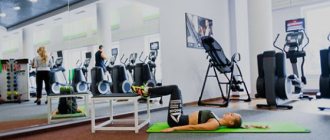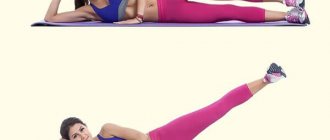There are many ways to quickly and effectively get your body in shape without resorting to the services of specialists or visiting a gym. If you yourself don’t know how to pump up your legs at home, you should consult a trainer who will select the necessary exercises.
One of the basic home exercises is jump squats.
An individually selected set of simple exercises for thin legs or for weight loss, which do not require additional equipment, will allow you to quickly pump up your legs or lose excess weight at home.
Important! Any sports training should begin with a warm-up. It allows you to preheat muscle tissue and increase its blood supply. Muscles become more elastic.
We also recommend studying this topic:
Effective leg training for weight in the gym
10615 0 0
What happens to muscles during exercise
The most general thing is that training injures muscle fibers, nutrition and recovery help them grow. During class, we perform exercises that damage muscle fibers and create stimuli for growth. When we rest, eat enough proteins, fats and carbohydrates, and sleep, the body's hormonal levels switch to anabolism. The muscles are “repaired”, since the body “understands” that they are needed, the person will soon load them again. Over time, the muscles increase, and the person acquires the physique that he wants.
In fitness theory, changes in the body and muscle tissue are divided into training periods.
Complete beginner
Let's imagine that someone has spent their entire life on the couch. At school he had an exemption from physical education, or some irregular activities like running or football. At the university, for a couple of years he didn’t go anywhere except bars, at all, and then he saw that no one liked a belly and thin arms, and shortness of breath did not add to personal effectiveness. Our imaginary hero decided to build up his muscles.
He bought dumbbells for home, a horizontal bar for the doorway, push-up bars, and dug up a set of weights at his grandfather’s dacha. He doesn’t go to the gym, because greedy trainers there cheat newcomers out of money. He goes to YouTube, where some blogger teaches him how to do push-ups and pull-ups while compensating for part of his body weight by jumping. So our hero does push-ups, pull-ups, squats without weight, and light exercises with dumbbells.
Over the course of a month, his nervous system gets used to “digesting” the load, sleep and appetite improve, and the sore throat that plagued him at the beginning after each lesson goes away. His strength gradually increases, so he can already do more than 20 push-ups, and he is forced to purchase stops and a weighted vest.
In the first 3-4 months, the growth in strength is directly proportional to the growth in technical skill, so when working with a trainer, tasks like pumping up muscles are not set. But you can’t motivate a beginner with this! He wants to quickly see the cubes in place of a soft belly, and the peak of biceps in place of thin “chicken” arms. Therefore, a competent coach will tell the ward about proper nutrition during this difficult period. By normalizing your diet, a person will look better in a matter of weeks. This will be the first visual result.
For training at this time, exercises with body weight or minimal weights are preferable. The program is built around push-ups, pull-ups, goblet squats, lunges with minimal weight, squats without weights and straight abdominal crunches. These exercises need to be performed slowly, and you need to pay attention to your technique.
Hypertrophy
The next couple of years are turning points in the life of a novice fitness specialist. The average person doesn’t see much results from home training and quits. Yes, this is because we were taught that muscles should grow as advertised, that is, in 3-4 months we should see significant changes. After suffering for six months, a person joins the “dusty dumbbells” club. Yes, those who lose weight have a greater chance of long-term friendship with sports. They achieve results mainly through proper nutrition. The more carefully they follow their diet, the better they are able to change themselves. Such people successfully lose weight, and then begin to gain muscle mass.
In general, if you take a disciplined guy who lifts weights 3-4 times a week, increasing the load progressively, and eats for “mass growth,” he will gain about 20 kg in a couple of years. Yes, not all of it will be muscles; the fat component will also increase partly. To prevent this from “spoiling the aesthetics” too much, experts recommend alternating mass-gaining cycles with “drying.” But the fact remains unchanged - in 2 years the genetic potential for muscle hypertrophy in most natural athletes is not exhausted.
Hyperplasia
This word refers to an increase in muscle volume due to the division of muscle fibers. By the way, not all scientific studies confirm that a person, in principle, is able to increase weight due to hyperplasia. Bodybuilding experts refer to the theory of Professor Seluyanov and recommend his methods. Or they suggest training at a high volume with light weights, and they say that this way a person will gain about 10 kg of muscle.
It’s sad, but only a few manage to test words in practice. The point here is not that people are lazy to exercise, but that most theorists very heavily use not only sports nutrition, but also anabolic steroids. Here the science is clear - a person who trains on sports pharmacology is capable of muscle hyperplasia. And his weight is growing much faster.
System adaptation
They say that not every bodybuilder can get to the stage where nothing else works. It's all about the notorious life circumstances. What helps a little here is that strength sports alternate in practice. Some people start just to build up muscles, and then go to CrossFit or powerlifting to start using these muscles. Others alternate between “mass” and “drying” and delay this moment. But when adaptation occurs, it is believed that the athlete can only maintain shape and ensure that injuries do not occur.
Build muscles at home. Home workout program.
Squats
You can quickly pump up your legs using various variations of squats. Increasing the number of repetitions with each workout and reaching 100 squats, it is recommended to perform them with weights.
You can squat with or without weight
You can use dumbbells or a barbell for this. To pump up your legs at home, you can use plastic containers of various sizes filled with sand or water as additional weight.
It is important to follow the execution rules. The body must be kept straight and the back straight. During a squat, your thighs should be parallel to the floor. When squatting, you cannot push your knees further than your toes.
We have previously written about exercises for girls to pump up their legs at home and recommended bookmarking this article.
Is it possible to pump up without exercise equipment?
Yes, you can pump up either at home or in the gym. But not everyone succeeds. Why? Lack of discipline, reluctance to learn technique, minimal knowledge about the progression of training loads. The truth is that the first couple of years a beginner should train like a powerlifter or weightlifter to gain mass naturally. Then you can apply the legacy of bodybuilding to its fullest.
What's the problem with home workouts? Of course, there is a lack of equipment. And you will miss not fashionable hack machines and some kind of cable and block exercise machines, but a power rack, a platform, a good bench press, and a competent spotter. Yes, you can strengthen your muscles without this stuff by using kettlebells and dumbbells, as well as doing pull-ups and other exercises with body weight. But if we are operating in categories like “gain 20 kg of muscle”, and not just “look like I’m rocking on the beach,” it’s better to go to the gym. Let it be the cheapest, basic, with old equipment, but for the hall.
Category: “Workouts in the gym”
, which is the basis of your worldview in the world of bodybuilding.
- Material “What is load progression?” The principle of progression of loads must be understood before you decide that bodybuilding is a part of your life.
- The article “Why can’t you train every day?” This material is a must-read for any enthusiast who believes that the principle of “more is better” works in bodybuilding.
- The text “What is supercompensation?”, which will allow you to come to a systematic understanding of the essence of bodybuilding.
- Material “Why do you need a training diary?” This text allows you to understand why training in the gym should be as systematic as possible.
- The article “How to pump up biceps?”, which allows a beginner to understand the principles of pumping up biceps and any other muscle.
Newbie mistakes
To begin with, those who want to know how to pump up at home google biceps exercises and begin to do them fanatically. But the point is not at all in the biceps, but in the absence in the body of the prerequisites for creating an anabolic background. Simply put, a person simply “has nothing to grow” muscles from, especially if he neglected nutrition and believed that if he was training at home, then mashed potatoes with sausage would pass for an athlete’s diet.
The most important mistake is the reluctance to develop strength. Yes, yes, all the athletes of the “golden era” were good strength athletes. And even any modern crossfitter will perform CCM on individual movements in powerlifting. But the gloss of sports convinces us that “it will do” - bend your arms with something, do some exercises in a high-repetition mode, and you will get pumped up. No. Strength, by the way, can be developed to a certain limit at home. The only question is desire.
High expectations
Yes, guys are even worse than girls in this regard. If the latter believe that after a couple of series of glute bridges without weight and some steps to the side with elastic bands, they will look like protruding fitness bikinis, then the former are ready to argue with foam at the mouth that the same Denis Gusev could to pump up on horizontal bars if he didn’t have access to the gym. Everyone needs a role model, but if you do home fitness, you don't need to set goals like “look like a model in 3 months.”
The myth of champion volumes
Almost any person who has a photo on Instagram with huge shoulders and biceps can fit into a standard suit in life. Yes, big guys pump up their muscles before recording the results of their labors. And poor beginners do 200 repetitions with biceps expanders just to get any closer. Of course, you can develop endurance in this way, but not strength or volume.
Lack of motivation
We are not talking about videos from the Internet, where guys from the ghetto do pull-ups on the horizontal bars, and their wealthier “sports colleagues” pump iron in expensive gyms. We are talking about banal laziness. Biceps and deltoids may not be a priority for a student - for example, he is ready to play a game until 2 a.m. and then sleep through the workout. Or go have a beer instead of working out on the horizontal bars. Or... And if summer comes, you should completely forget about your studies. It's hot! In winter it is cold. In autumn - depression. And so on, in a circle. The one who will fanatically carry out the exercise program for years will get pumped up.
How to Build ALL Muscles at Home WITHOUT Iron!
Exercises without machines for beginners
The truth is that it is better for a beginner not to buy equipment for home at all. It is not yet known whether he will like to study, whether he will devote enough time to physical development, or whether he will abandon the whole thing halfway and return to the sofa.
With body weight you can do:
- “air” squats and lunges;
- Bulgarian split squats with one leg resting on the sofa;
- pistol squats;
- push-ups with different hand widths;
- pull-ups with different arm widths;
- planks, supermen, crunches
Exercises for bodyweight training from upper body to lower body
Upper body thrust (Vertical):
- Freehand push-ups
- Push-ups with hand support against a wall
- Push-up with legs raised and bent at 90˚
Drop sets of vertical push-ups for the upper body
Pull-up (Vertical) upper body:
- Pull-ups with palms facing each other (neutral grip)
- Straight grip pull-up (neutral grip)
- Pull-ups with corner hold
Drop sets of vertical pull-ups for the upper body
Lower body:
- Walking pistol squats
- Walking Squats/Lunges with Long Steps
- Walking Squats/Lunges with short steps
Drop sets for the lower body
The best exercises without iron
Simple squat
Stand up straight, cross your arms in front of your chest, try to keep your back vertical, and do not pull your buttocks back. With an inhalation, lower yourself down, spreading your knees to the sides, your pelvis below your knees. Exhale – stand up straight. Do not lean forward, do not change the position of your back, and do not change the position of your knees - do not bring them inward.
Lunges
This exercise is similar to a side squat. From the starting position for a simple squat, you need to step back with one leg and leave the other in the “heel under the pelvic bone” position. Then perform a squat until your knee touches the floor. You should do the same number of lunges on each leg.
Bulgarian squats
Technically, this is a lunge with the “back” leg fixed on a sofa or other support. You need to lower yourself straight, so that the knee of the front leg is not “sharp”, and the angle between the shin and the floor remains straight.
Pistol squats
Technically they resemble regular ones, but you need to stand on a low support (for example, a step or step, if you have one at home), bend your knee and lower yourself so that your pelvis is below the knee. Reaching the starting position should be done without rocking the body back and forth.
Push ups
This exercise is known to everyone from school physical education lessons. A beginner should start with the palms in the middle position - under the shoulders. Your arms should be perpendicular to the floor and your feet should be supported. The back is tense, the hips are too. You need to smoothly lower your chest to the floor, spreading your elbows, and smoothly push up from the floor.
Pull-ups
It is also better to start pull-ups with a medium grip width. Hang on the horizontal bar, palms facing away from your face, and gently bend your elbows. Pull your chest toward the bar and lower yourself straight down.
Plank and side plank
You need to take the starting position for push-ups, tighten your abs, pull in your stomach, and spend from 30 seconds to 1 minute in this static position. The side plank is an exercise on the forearm, with the side parallel to the floor.
Superman
Lying on your stomach, lift your hips and legs, as well as your arms and head, off the floor. From the outside it looks like Superman flying. An exercise can be either dynamic, when sets and repetitions are performed one after another, or static, when a person freezes at the top point and does not perform the movement dynamically.
Crunches and reverse crunches
From a lying position on the floor, you need to either lift the body and bring the lower ribs to the pelvic bones, or lift the pelvis and legs up at the same time. In both movement options, the lower back should be pressed to the floor and the abs should be tightened.
You can do other exercises - burpees, squat jumps, and lunges, but they have nothing to do with pumping up muscles. These are functional movements for developing general endurance, which are used in athletics and martial arts.
how to build muscle at home
Light exercises
A newbie should add a bar to their list. To perform the exercise, you need to rest your toes on the floor. Bend your arms at the elbows and place them in front of you. The stomach and spine should be kept straight. The weight will be supported by the forearm and shoulders. You should use a timer for this exercise. The plank should be performed for 90 seconds. There is also another variation to this exercise. To perform, you need to keep all the weight on one hand. The oblique abdominal muscles will be loaded.
With the help of the “Superman” exercise, athletes pump up their abs and back. To perform this, you need to lie on your stomach and start raising your arms and legs up. You need to stay in this position for several seconds. After this, repeat this action 10 more times.
You can also pump up your abs with crunches and leg raises. To do this you need to lie on your back. Heels should not touch the floor. Afterwards, do the exercise, connecting the knees and chest. In this way, almost all abdominal muscles will be tensed.
Many people are interested in how to pump up their shoulders at home without dumbbells. To do this, you need to learn how to stand on your hands while leaning on the wall. Then try to touch your head to the floor and then get up. At the very beginning, this exercise is difficult to do. In this case, you need to seek help. Another person can hold your feet, thereby reducing the load.
The “Burpee” exercise is suitable for people who are interested in how to pump up at home without exercise equipment. With its help, almost all the muscles of the body are tensed. Standing in the starting position, a person needs to quickly lie on the floor and do push-ups. After that, get up and jump again. Then return to the starting position. Then repeat the entire algorithm of actions again. Athletes recommend doing “Burpees” for several minutes.
Equipment for full training at home
There are ideal options, and there are low-budget ones. In the first case, a garage is allocated for training; it contains a power frame, a barbell, a platform, a bench for bench press, and a set of weights. Additionally - dumbbells. By the way, it’s not all that expensive to buy. You can search on Avito, at sales, and also from private owners. Many people will be happy to get rid of equipment they don't use. And modern equipment manufacturers make a lot of good hardware with small home gyms in mind.
If the budget is strictly limited, you will still have to choose small equipment:
- Fitness mat;
- Bench or step;
- Dumbbells with the ability to change weight - stackable;
- Horizontal bar and parallel bars, or horizontal bar and push-ups;
- Rubber shock absorbers
How to replace all this?
The steps of the ladder replace the stepper, and two strong chairs replace the push-ups. But nothing can replace the burden. Yes, you can write a lot of good things about the benefits of exercises with water bottles, sandbags, and natural stones, but this is all fine if a person knows how to hold his back. If he doesn’t know how to simultaneously gather his shoulder blades toward his spine and contract his abs, then he’s unlikely to be able to lift weights well in the same goblet squat with a water bottle.
Therefore, if you can’t buy weights for yourself, it’s better to train on parallel bars and horizontal bars for now, while looking for dumbbells and barbells at flea markets or Avito. For those who do not believe that bodyweight exercises can be difficult, there are manuals on callisthenics.
A set of exercises for all muscle groups
For beginners, it is better to practice fullbody programs at home. They don’t need splits yet, that is, differentiation into “top”, “bottom” or by muscle groups, since the fullbody will provide an overall increase in load faster.
Workout 1
- Plank – 3 minutes, broken down
- Standing Dumbbell Press – 3 sets of 12 reps
- Pull-ups with rubber or shock absorber pull to the chest from a vertical position – 3 to 10-12
- Romanian dumbbell row or forward bend with dumbbells – 3 x 10
- Classic lunges – 3 to 12.
Workout 2
- Side plank – 3 minutes on each side
- Push-ups with weights or regular 3 to 12
- Bent-over dumbbell rows 3 x 12
- Squat with 1 dumbbell on the chest – 3 to 12-15
- Bulgarian split squats without weight – 3 x 12-15
You can perform these complexes one after another every other day. The training regimen can be set every other day, or twice a week, if recovery is really bad. Ideally, increase working weights when a strength plateau occurs - take dumbbells a little heavier, but reduce the number of repetitions by two.
Weekly exercise program
MONDAY | BACK, CHEST, DELTS, PRESS
- Pull-up on the bar with a wide grip to the chest
The first approach is a warm-up, we perform without weight, the next 5 approaches we do with weights. A durable backpack with a dumbbell in it or loaded with sand will be a good weighting agent.
We pull ourselves up to the bar quickly, and lower ourselves slowly. At the end of each approach, do 3-4 more partial repetitions. The use of wrist straps is mandatory. Number of approaches – 5, repetitions 8-12. Rest between sets – 60-90 seconds.
This is a universal complex that will suit every person. In it you can change some exercises or complicate them. A week you need to devote 3 days to training and 4 days to rest. Exercise program:
- Monday. At the very beginning, do a five-minute warm-up. After this, do crunches 4 sets of 15 times. Next comes wide-grip pull-ups. You need to do 4 sets of 10 repetitions. Then start doing push-ups. You need to do 4 sets of 20 times.
- Wednesday. Warm up before training. Then do lunges. You need to do 4 sets of 12 repetitions. Next, start squats. Do 20 reps for five sets.
- Friday. Warm up for five minutes. Afterwards, do abdominal exercises. Lie on the floor and raise your legs up. Do 4 sets of 15 reps. After this, start doing push-ups. You should do this 12 times in 4 approaches. If there are uneven bars, then you also need to practice on them. The recommended load is 10 repetitions of 4 sets.
The remaining days should be given to rest. Many people are also interested in how to pump up their arms with dumbbells at home. To do this, add an exercise using this equipment to your workout. You should do 20 repetitions and 5 sets. The recommended weight of one dumbbell for a beginner is 8 kg. Gradually the load should be increased.
To grow muscle mass, you need to eat right and sleep at least 8 hours a night. Experts recommend eating 6 times a day. The diet should contain 2 grams of protein per 1 kilogram of body weight. Also 0.5g fat and 4g carbs. The calorie content of food should be at least 2000 kcal. Nutritionists recommend eating meat, fish, eggs, dairy products and various cereals.
How to develop your legs
It is often mistakenly believed that jumping and jumping “swing” the legs. Repeated jumping rope, running and other cardio activities are more likely to develop endurance. To develop strength, you will either have to jump on a support, for example, a box 50 cm high, or perform movements with weights.
You can realistically do the following movements at home:
- Goblet squats and pause squats;
- Lunges with dumbbells;
- Squats with dumbbells on the chest and a rubber shock absorber;
- Dumbbell floor rows and Romanian rows
- If more significant weight is required, it is recommended to either add rubber shock absorbers, or switch to “one-legged” versions of squats and deadlifts, or, nevertheless, go to the gym.
Another group of bodyweight exercises
Again, if the first move on the list is too advanced for you right now, just start with the second move.
Upper body thrust (Horizontal):
- Bent-knee plank push-ups on parallel bars
- Push-ups with legs raised
- One leg push up
Drop sets of horizontal push-ups for the upper body
Pull-up (Horizontal) upper body:
- Pull-ups parallel to the floor with one or two knees bent
- Australian pull-up (straight legs)
- Australian pull-up (knees bent)
Drop sets of horizontal pull-ups for the upper body
Lower body:
- Hip/glute raise with legs and shoulders raised
- Hip/glute raise while lying on your back with your legs elevated (hands on the floor)
- Hip/butt lift while lying on your back (hands on the floor)
Drop sets for the lower body
Arm muscle development
There are just few features here - the same exercises are done as in the gym, only with dumbbells.
Bicep curls
While sitting or standing, you need to press your forearms to your body, and bend your elbows, lifting the dumbbells to your shoulders, and then slowly lower them.
Triceps overhead extensions
Sitting on a bench, lift one dumbbell behind your head and gently straighten your arms at the elbows. There is no need to “insert” your elbows until they click, smoothness is important.
Standing Dumbbell Shoulder Press
You need to stand up straight, bring the projectiles to your shoulders and smoothly move them along an arcuate path to the top of your head.
Advantages and disadvantages of cardio training at home
Pros of working out at home:
- Save time. You can study at home at any convenient time.
- Classes can be done with your family. This is true for young mothers who cannot leave their baby for a long time.
And also, when buying a gym membership, everyone runs the risk of missing part of the classes due to their children’s illness or other circumstances.
- Workout without embarrassment. The presence of other people can cause embarrassment and anxiety, which can be a big problem for your workout productivity.
Minuses:
- Lack of a well-designed training program.
- Incorrect exercise technique. Indeed, without a trainer it is very difficult to assess the correctness of the exercises, which can negatively affect the results.
- The need to focus on training. At home, the atmosphere is conducive to relaxation, but thoughts about various household concerns can distract you.
- Lack of motivation.
Features of training for girls
“Women’s” training is not much different from men’s. A newbie girl can do the same basic fullbody plan. If she wants to focus on the buttocks, you can add 1-2 sets of leg swings back with weights or a band, and hip abductions to the side. But all this is not necessary. At the beginner level, it is better to ensure regular training and avoid technical mistakes.
There are few basic rules:
- The priority is strength. Cardio can be replaced by walking, cycling, or not done at all, just walking 10,000 steps a day;
- Training should be regular, every other day. No matter how much you would like to train only “problem areas,” you need to do exercises for the whole body, otherwise the risk of injury increases;
- You still have to eat right; you can’t achieve everything through training and a “calorie deficit” alone.
Nutrition
Mass training requires at least 4 g of carbohydrates and 2 g of protein per kilogram of weight. In this case, it is better to keep fats at the level of 1 g per kilo of current body weight. Getting calories from natural foods is a must.
Recommendations:
- Drink 2-3 liters of plain water;
- Avoid empty calories from sauces, sugar and fast food;
- Eat regularly, at regular intervals
Cardio at home without exercise equipment for women
As a result of cardio blood circulation speed increases , blood flow to all muscle groups improves, metabolic processes accelerate, and the body releases a large amount of water.
The last aspect is very important when losing weight , since fats begin to break down only after carbohydrates are processed, the breakdown product of which is water.
Reference! During the first 20 minutes of aerobic training, only blood sugar and glycogen are consumed.
Contraindications
It is important to correctly adjust the duration and intensity of classes, take into account individual characteristics and the presence of contraindications:
- diseases of the cardiovascular system;
- lactation;
- pregnancy.
Selecting the intensity and monitoring the load on the heart
Cardio training is primarily a load on the heart and blood vessels . Heart rate (HR) is an indicator that must be taken into account when choosing a training program.
Individual heart rate norms are determined simply:
- 220 – age – maximum heart rate for men;
- 214 – age – maximum heart rate for women.
The optimal values for the number of heartbeats are 75–95% of the upper limit of indicators.
In the presence of heart disease and other contraindications to intense exercise, the heart rate should be 60–70% of the upper limit.
These standards will ensure the effectiveness and safety of training.
Attention! You should calculate your heart rate before training, and you need to constantly monitor the indicators to ensure the effectiveness of the training.
The optimal training regimen is 3-4 times a week for 30-45 minutes.
Ideal products
All these natural products will help you gain weight:
- Pasta, potatoes and sweet potatoes for carbohydrates;
- Legumes of all types - for carbohydrates and protein;
- Rice is the most accessible source of energy for a bodybuilder;
- Eggs, poultry – protein;
- Fish and seafood – protein and omega-three;
- Beef and offal – protein and iron;
- Vegetables - fiber;
- Fruits – energy of vitamins and natural simple carbohydrates;
- Nuts – for healthy fats
